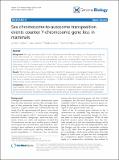| dc.contributor.author | Hughes, Jennifer F | |
| dc.contributor.author | Skaletsky, Helen | |
| dc.contributor.author | Koutseva, Natalia | |
| dc.contributor.author | Pyntikova, Tatyana | |
| dc.contributor.author | Page, David C | |
| dc.date.accessioned | 2018-07-05T14:10:24Z | |
| dc.date.available | 2018-07-05T14:10:24Z | |
| dc.date.issued | 2015-05 | |
| dc.date.submitted | 2015-02 | |
| dc.identifier.issn | 1474-760X | |
| dc.identifier.uri | http://hdl.handle.net/1721.1/116788 | |
| dc.description.abstract | Background: Although the mammalian X and Y chromosomes evolved from a single pair of autosomes, they are highly differentiated: the Y chromosome is dramatically smaller than the X and has lost most of its genes. The surviving genes are a specialized set with extraordinary evolutionary longevity. Most mammalian lineages have experienced delayed, or relatively recent, loss of at least one conserved Y-linked gene. An extreme example of this phenomenon is in the Japanese spiny rat, where the Y chromosome has disappeared altogether. In this species, many Y-linked genes were rescued by transposition to new genomic locations, but until our work presented here, this has been considered an isolated case. Results: We describe eight cases of genes that have relocated to autosomes in mammalian lineages where the corresponding Y-linked gene has been lost. These gene transpositions originated from either the X or Y chromosomes, and are observed in diverse mammalian lineages: occurring at least once in marsupials, apes, and cattle, and at least twice in rodents and marmoset. For two genes - EIF1AX/Y and RPS4X/Y - transposition to autosomes occurred independently in three distinct lineages. Conclusions: Rescue of Y-linked gene loss through transposition to autosomes has previously been reported for a single isolated rodent species. However, our findings indicate that this compensatory mechanism is widespread among mammalian species. Thus, Y-linked gene loss emerges as an additional driver of gene transposition from the sex chromosomes, a phenomenon thought to be driven primarily by meiotic sex chromosome inactivation. | en_US |
| dc.description.sponsorship | National Institutes of Health (U.S.) (Grant HG000257) | en_US |
| dc.publisher | Biomed Central Ltd | en_US |
| dc.relation.isversionof | http://dx.doi.org/10.1186/S13059-015-0667-4 | en_US |
| dc.rights | Creative Commons Attribution 4.0 International License | en_US |
| dc.rights.uri | http://creativecommons.org/licenses/by/4.0/ | en_US |
| dc.source | BioMedCentral | en_US |
| dc.title | Sex chromosome-to-autosome transposition events counter Y-chromosome gene loss in mammals | en_US |
| dc.type | Article | en_US |
| dc.identifier.citation | Hughes, Jennifer F et al “Sex Chromosome-to-Autosome Transposition Events Counter Y-Chromosome Gene Loss in Mammals.” Genome Biology 16, 1 (May 2015): 104 © 2015 Hughes et al | en_US |
| dc.contributor.department | Massachusetts Institute of Technology. Department of Biology | en_US |
| dc.contributor.mitauthor | Page, David C | |
| dc.relation.journal | Genome Biology | en_US |
| dc.eprint.version | Final published version | en_US |
| dc.type.uri | http://purl.org/eprint/type/JournalArticle | en_US |
| eprint.status | http://purl.org/eprint/status/PeerReviewed | en_US |
| dc.date.updated | 2018-07-02T14:25:48Z | |
| dspace.orderedauthors | Hughes, Jennifer F; Skaletsky, Helen; Koutseva, Natalia; Pyntikova, Tatyana; Page, David C | en_US |
| dspace.embargo.terms | N | en_US |
| dc.identifier.orcid | https://orcid.org/0000-0001-9920-3411 | |
| mit.license | PUBLISHER_CC | en_US |
